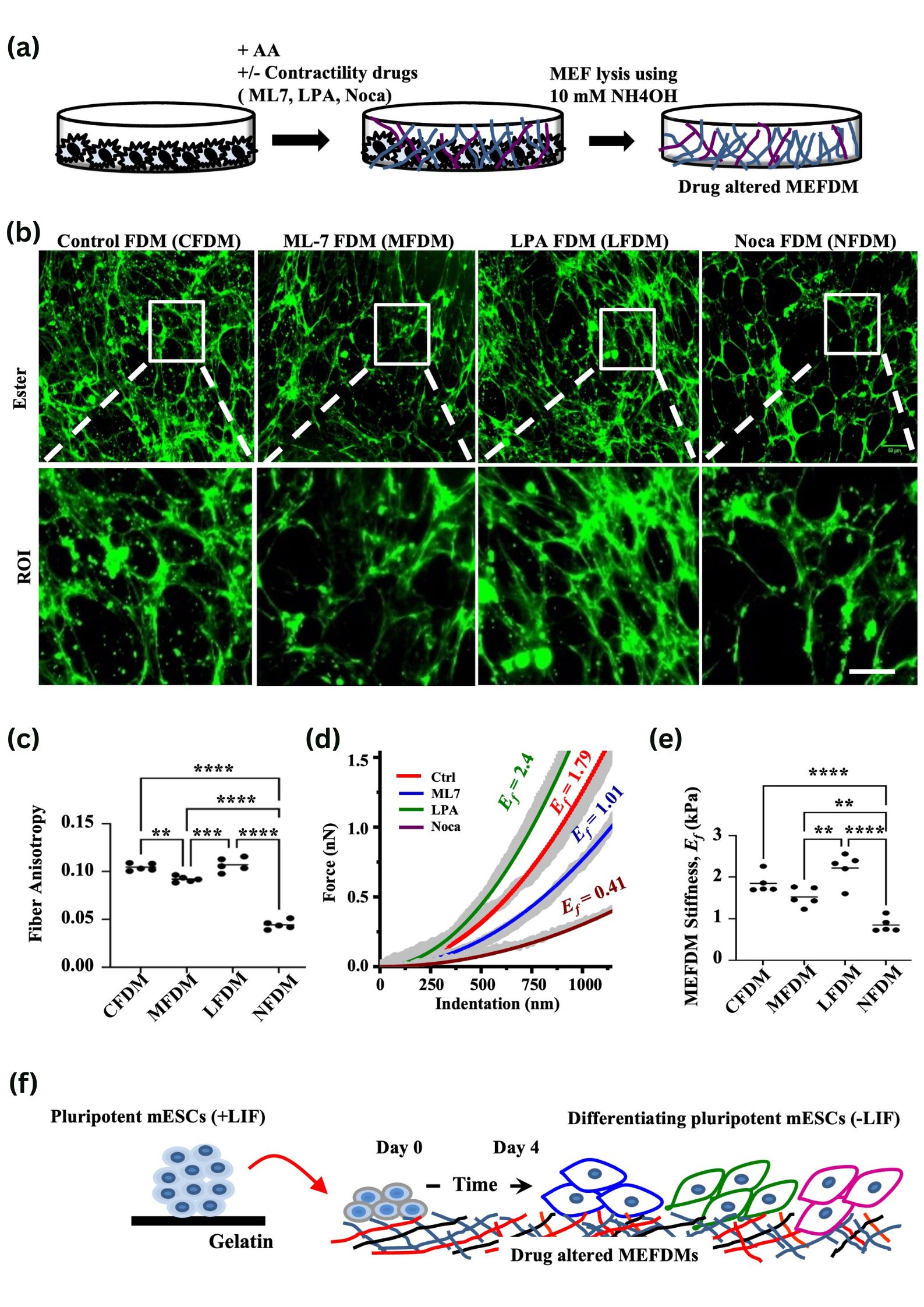This patent discloses the development of extracellular matrix (ECM) scaffolds designed for preparation and use in tissue engineering and regenerative applications. Stem cells are used in the treatment of various human diseases and it is an extensively researched topic. ECMs provide physical scaffolding for cells and largely decide the biomechanical properties of the stem cell niche. However directing ESCs into single functional cells is difficult as stem cells differentiate into different cell types. The ECM scaffolds developed include altered ECM components synthesized by tuning fibroblast cells of a single origin. This results in ECMs which allow stem cells to expand and differentiate into specific lineages with varying biophysical properties to support stem cell viability and targeted differentiation.
Figure 1. The characterization of MEFDMs (Mouse Embryonic Fibroblast-Derived Matrices) and mESC (Mouse Embryonic Stem Cell): (a) Preparation of MEFDMs: Schematic of preparation of contractility altered MEFDMs; (b) Cell Organization: The organization of MEFDMs was visualized using ester staining; (c) Fiber Anisotropy: Quantification of fiber anisotropy of different MEFDMs; (d) Cell Stiffness: Schematic of probing MEFDM stiffness with soft, pyramidal AFM cantilever to obtain estimates of MEFDM stiffness; (e) Stiffness Quantification of MEFDMs synthesized by MEFs; (f) mESC Differentiation Schematic: Pluripotent mESCs cultured with LIF on gelatin-coated dishes were transferred to MEFDMs without LIF
Embryonic stem cells or ESCs have great therapeutic capabilities because of their ability to differentiate into multiple functional cells in the body. Induced pluripotent stem cells or iPSCs are adult cells reprogrammed into an embryonic stem cell-like state. However directing ESCs/iPSCs into single functional cells is extremely difficult because they spontaneously differentiate into different cell types resulting in a mixed population of cells. The lack of sorting protocols for mixed populations limits the use of ESCs and iPSCs in clinical applications. Since the biomechanical properties of the stem cell niche are dependent on extra cellular matrix (ECM) components, ECM scaffolds developed by altering ECM components by tuning fibroblast cells of a single origin can be used for stem cell expansion and differentiation.
- ECM Scaffolds: A composition for the synthesis of ECM scaffolds comprises fibroblast cells and a cell culture medium containing specific contractility modulators. The method for synthesizing ECM scaffolds involves culturing fibroblast cells, treating them with decellularizing agents, and isolating the resulting ECM. These scaffolds are capable of supporting the expansion and differentiation of various stem cell types, including embryonic stem cells (ESCs), tissue-specific stem cells, mesenchymal stem cells, and induced pluripotent stem cells (iPSCs).
- Stem Cell Viability: The ECM scaffolds have unique biophysical properties and it improves stem cell viability and output in directing cells into specific lineage.
- Lineage-Specific Differentiation: It allows for the production of lineage-specific stem cells and supports the synthesis of endogenous growth factors.
- MMP Production: It can also induce production of Matrix metalloproteases (MMPs) during differentiating stem cells.
- ECM Production: The method can produce ECMs from fibroblast cells of a single origin.
The prototype for the ECM scaffolds involves a standardized process that combines fibroblast cells with specific contractility modulators in a cell culture medium. After culturing cells for specific duration, cells are treated with decellularizing agents to obtain the ECM. These scaffolds can support the expansion and differentiation of various stem cell types, with their biophysical properties optimized to enhance stem cell viability and targeted differentiation. By utilizing fibroblasts from individuals, the process can be personalized to generate patient-specific 3D matrices that can subsequently be utilized for various therapeutic purposes.
The technology enables generation of matrices of controlled stiffness and topography. These matrices closely recapitulate the physicochemical properties of native tissues, and can therefore be utilized for regenerative medicine applications as well as for drug screening.
The next step would be to scale up the technology for specific applications.
4
The technology can be personalized and may serve as an alternative to animal testing.
The ECM scaffolds prepared using this method can be used for repair and regenerative applications, tissue engineering applications, stem cell research and therapy, and pharmaceutical development.
Geography of IP
Type of IP
202021029946
521075

